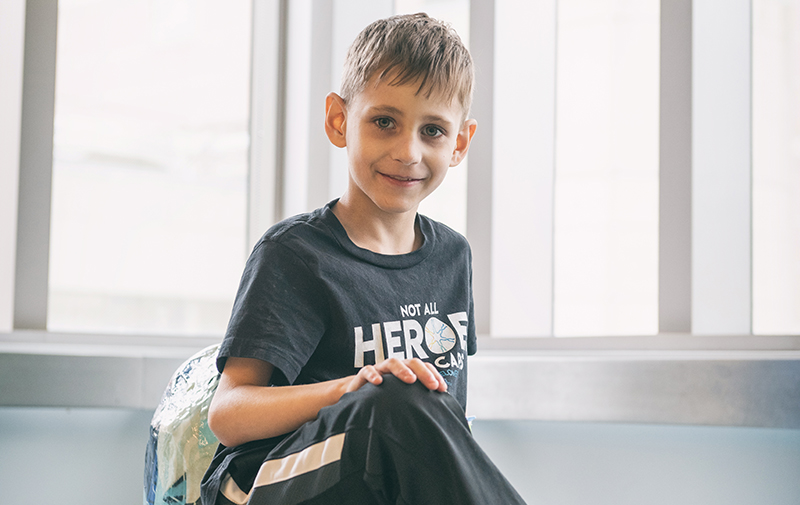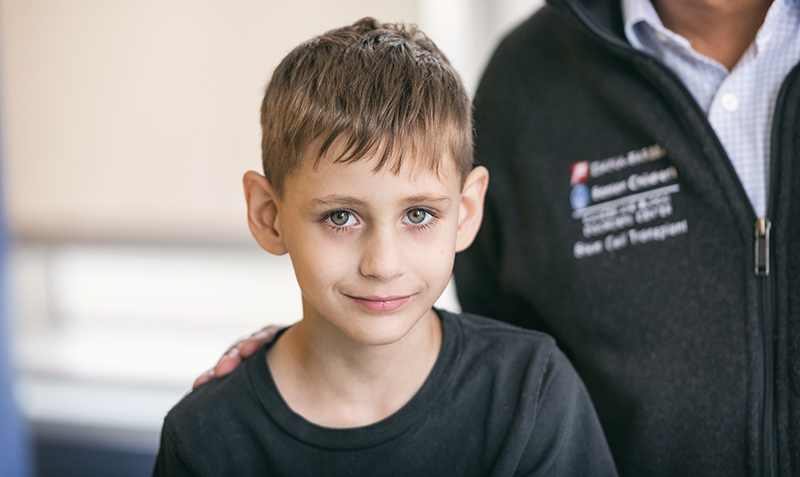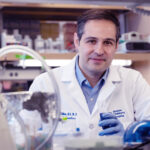Not all heroes wear capes: Taking on dyskeratosis congenita

When Mason Langlais argues with his sister, Jillian, he regularly repeats a mantra. “I’m the rare one,” he says. “So, you can’t treat me like this.”
“Rare” and “one in a million” — those are just a few of the words his mom, Jenn, uses to describe her 7-year-old self-proclaimed super hero. It’s how she explains away the many trips to the hospital, the umpteenth blood test, and the hours spent in his bed or hospital bed, too sick to go to school.
“One day, Mason asked me, ‘Why don’t my friends have to go through this?’ recalls Jenn. “And I said, ‘Well, buddy, it’s just because you were made differently. That’s what makes you special.”

Dyskeratosis congenita
Mason is rare — as his mom duly noted — because he was born with dyskeratosis congenita (DC), a progressive condition that is believed to affect only one person in 1 million. It is both predictable in that its most common manifestation is bone marrow failure and unpredictable in that no two patients are symptomatically alike.
DC is classified under a broad spectrum of genetic disorders, known as telomere diseases. The underlying cause is the presence of shortened telomeres — the protective cap at the end of chromosomes. DC gene abnormalities disable the ability to maintain telomeres. Cells stop dividing, leading to potential complications, such as organ failure and cancer.
There is no cure, and treatment options are limited. A bone marrow transplant can potentially cure the blood abnormalities associated with the condition; however, it does not improve the other tissues affected. In addition, people with DC have an increased sensitivity towards the radiation and chemotherapy used during the transplant-conditioning process that prepares the body for the new donor cells.

Drawn together by Team Telomere
Shortly before Mason’s diagnosis, Jenn connected with the Team Telomere community, a patient advocacy group for families affected by DC and other telomere disorders.
“With Team Telomere, I can reach out to any member all over the world, and find comfort in knowing they have the right words to say,” she says.
To Jenn, Dr. Suneet Agarwal, a Team Telomere medical advisory board member and co-program leader for the Stem Cell Transplant Center at Dana-Farber/Boston Children’s Cancer and Blood Disorders Center, is a rock star, a hematologist who puts human beings first.
“I can write him an email any time day or night and within hours he will write back,” says Jenn. “He just cares so much.”
Dr. Agarwal has been immersed in the biology and care of children with DC for years. His connection to Team Telomere and dedication to DC inspired him to organize a clinic on their behalf. This September marks the clinic’s second year.
“It’s an opportunity for families — even from far away — to have their kids seen by complex-disease specialists across our institution,” he says.

Everybody wants a happy ending
The Langlais family drives all the way from Front Royal, Virginia, to Boston for the Telomere Clinic. Mason is nearly two years post bone marrow transplant and by all accounts, has done remarkably well.
At age 4, he was a participant in a first-of-its-kind clinical trial, led by Dr. Agarwal, to test the success of bone marrow transplants without the use of radiation and chemotherapy.
“The good news is we can take a child, like Mason, who is completely transfusion dependent, and he can go back to having a decent quality of life,” says Dr. Agarwal. “However, this is a disorder that causes many parts of the body to fall apart, and although the bone marrow transplant fixes the blood complications, it doesn’t fix everything.”
Last week, a day following Mason’s clinic visit, Jenn and Patrick learned Mason has the early stages of liver disease and lung failure, complications of DC they have witnessed far too many times within their Team Telomere community.
“I was prepared this might be in our future, but I thought we would have more time,” says Jenn. “Everybody wants a happy ending, but we can’t always give people that.”
For Dr. Agarwal, the news is painfully familiar. He describes detecting these early findings as a double-edged sword. “There’s nothing about Mason’s clinical status that would suggest this is happening, he is doing great. But we have started looking harder because of the emerging natural history in other DC patients, and now we are finding these early signs of disease,” he says. “Knowledge is power, but it’s very hard to see a change like this happen before your eyes when you don’t have a fix for it. We are working very hard to find solutions.”
In spite of everything, Jenn does her best to remain hopeful, even as she stands in a house that she says “looks like somebody has taken a snow globe and just shaken it up.”
“I used to worry about those things, about the house being in disarray, but now we just push happiness, because we don’t know what tomorrow will bring us — or even the next moment.”
Get more information about the clinical trial on dyskeratosis congenita.
Related Posts :
-

Promising advances in fetal therapy for vein of Galen malformation
In 2024, Megan Ingram* of California and her husband were preparing for the birth of their third child when a 34-week ...
-

A case for Kennedy — and for rapid genomic testing in every NICU
Kennedy was born in August 2025 after what her parents, John and Diana, describe as an uneventful pregnancy. Soon after delivery, ...
-

The hidden burden of solitude: How social withdrawal influences the adolescent brain
Adolescence is a period of social reorientation: a shift from a world centered on parents and family to one shaped ...
-

The journey to a treatment for hereditary spastic paraplegia
In 2016, Darius Ebrahimi-Fakhari, MD, PhD, then a neurology fellow at Boston Children’s Hospital, met two little girls with spasticity ...





